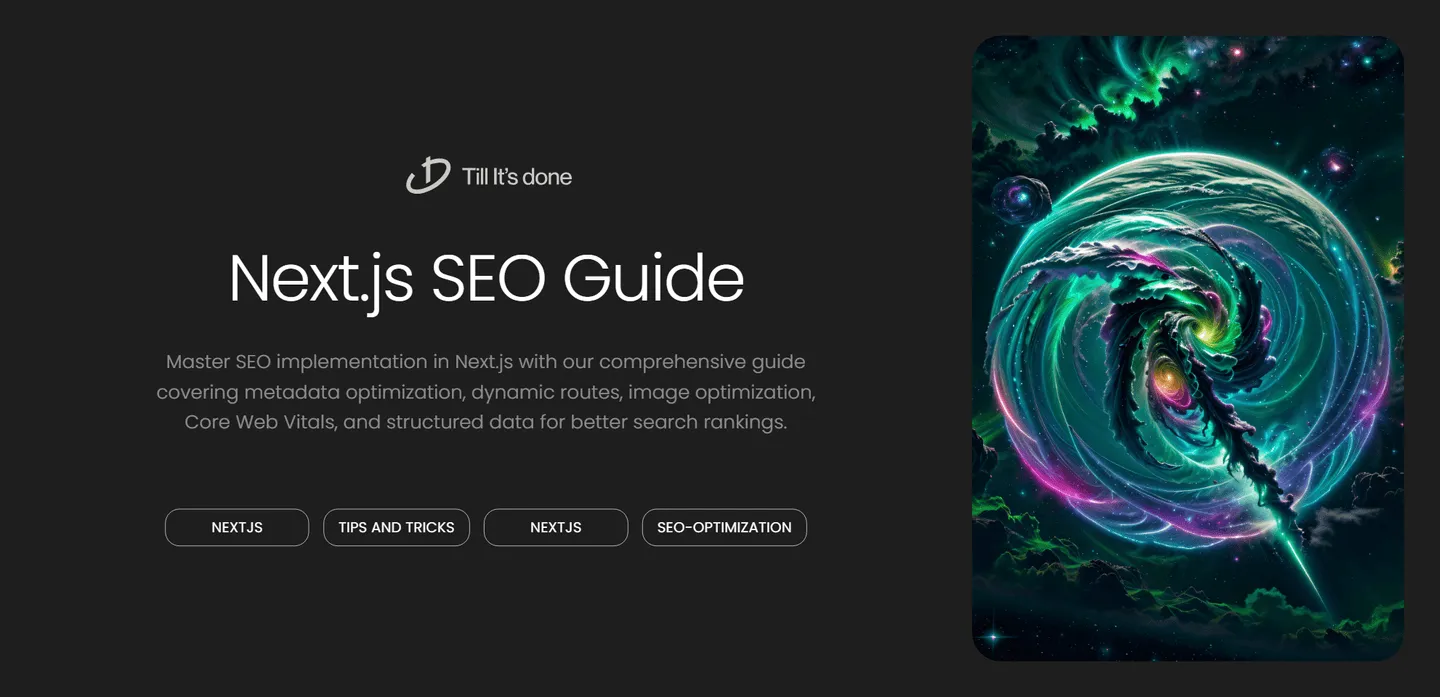- Services
- Case Studies
- Technologies
- NextJs development
- Flutter development
- NodeJs development
- ReactJs development
- About
- Contact
- Tools
- Blogs
- FAQ
SEO Best Practices in Next.js Projects Guide


As web developers, we’re always striving to build fast, efficient, and discoverable applications. Next.js has become a go-to framework for React developers, not just for its powerful features but also for its built-in SEO capabilities. Today, let’s dive deep into implementing SEO best practices in your Next.js projects that will help boost your search rankings.
Metadata API: Your SEO Foundation
Next.js 13+ introduced the powerful Metadata API, revolutionizing how we handle SEO. Unlike traditional meta tags, this API provides a more intuitive and type-safe way to manage your metadata.
Here’s how you can leverage it effectively:
export const metadata = { title: { default: 'My Website', template: '%s | My Website' }, description: 'Experience the best of web development', openGraph: { title: 'My Website', description: 'Experience the best of web development', url: 'https://mywebsite.com', siteName: 'My Website', images: [ { url: 'https://mywebsite.com/og.jpg', }, ], locale: 'en_US', type: 'website', },}
Dynamic Routes and SEO
One of Next.js’s strongest features is its dynamic routing system. When it comes to SEO, handling these routes properly is crucial for search engine crawlers.
Implementing Dynamic SEO
For dynamic routes, generate unique metadata for each page:
export async function generateMetadata({ params }: { params: { slug: string } }) { const post = await getPost(params.slug)
return { title: post.title, description: post.excerpt, openGraph: { title: post.title, description: post.excerpt, images: [post.coverImage], } }}Optimizing Images for SEO
Next.js’s Image component is a powerful tool for SEO. It automatically optimizes images and implements best practices:
import Image from 'next/image'
export default function ProductImage() { return ( <Image src="/product.jpg" alt="Detailed product description" width={800} height={600} priority={true} loading="eager" /> )}
Performance and Core Web Vitals
Remember, SEO isn’t just about metadata. Google heavily weighs Core Web Vitals in ranking decisions. Next.js helps you optimize these metrics through:
- Automatic Image Optimization
- Built-in Code Splitting
- Server-Side Rendering
- Incremental Static Regeneration
Implementing a Sitemap
Don’t forget to implement a sitemap for better crawling:
export default async function sitemap() { const baseUrl = 'https://mywebsite.com' const posts = await getAllPosts()
return [ { url: baseUrl, lastModified: new Date(), }, ...posts.map((post) => ({ url: `${baseUrl}/blog/${post.slug}`, lastModified: new Date(post.updatedAt), })), ]}Structured Data for Rich Results
Implement structured data to enhance your search results appearance:
export default function ProductPage() { return ( <> <script type="application/ld+json" dangerouslySetInnerHTML={{ __html: JSON.stringify({ "@context": "https://schema.org", "@type": "Product", name: "Product Name", description: "Product description", price: "19.99", currency: "USD" }) }} /> </> )}By implementing these SEO best practices in your Next.js project, you’re setting yourself up for better search engine visibility and improved user experience. Remember to regularly test your implementation using tools like Google Search Console and Lighthouse to ensure everything is working as intended.

 สร้างเว็บไซต์ 1 เว็บ ต้องใช้งบเท่าไหร่? เจาะลึกทุกองค์ประกอบ website development cost อยากสร้างเว็บไซต์แต่ไม่มั่นใจในเรื่องของงบประมาณ อ่านสรุปเจาะลึกตั้งแต่ดีไซน์, ฟังก์ชัน และการดูแล พร้อมตัวอย่างงบจริงจาก Till it’s done ที่แผนชัด งบไม่บานปลายแน่นอน
สร้างเว็บไซต์ 1 เว็บ ต้องใช้งบเท่าไหร่? เจาะลึกทุกองค์ประกอบ website development cost อยากสร้างเว็บไซต์แต่ไม่มั่นใจในเรื่องของงบประมาณ อ่านสรุปเจาะลึกตั้งแต่ดีไซน์, ฟังก์ชัน และการดูแล พร้อมตัวอย่างงบจริงจาก Till it’s done ที่แผนชัด งบไม่บานปลายแน่นอน  Next.js สอน 14 ขั้นตอนเบื้องต้น: สร้างโปรเจกต์แรกใน 30 นาที เริ่มต้นกับ Next.js ใน 14 ขั้นตอนเพียงแค่ 30 นาที พร้อม SSR/SSG และ API Routes ด้วยตัวอย่างโค้ดง่าย ๆ อ่านต่อเพื่อสร้างโปรเจ็กต์แรกได้ทันทีที่นี่
Next.js สอน 14 ขั้นตอนเบื้องต้น: สร้างโปรเจกต์แรกใน 30 นาที เริ่มต้นกับ Next.js ใน 14 ขั้นตอนเพียงแค่ 30 นาที พร้อม SSR/SSG และ API Routes ด้วยตัวอย่างโค้ดง่าย ๆ อ่านต่อเพื่อสร้างโปรเจ็กต์แรกได้ทันทีที่นี่  วิธีสมัคร Apple Developer Account เพื่อนำแอปขึ้น App Store ทีละขั้นตอน อยากปล่อยแอปบน App Store ระดับโลก มาอ่านคู่มือสมัคร Apple Developer Account พร้อมเคล็ดลับ TestFlight และวิธีอัปโหลดที่ง่ายในบทความเดียวนี้ได้เลย
วิธีสมัคร Apple Developer Account เพื่อนำแอปขึ้น App Store ทีละขั้นตอน อยากปล่อยแอปบน App Store ระดับโลก มาอ่านคู่มือสมัคร Apple Developer Account พร้อมเคล็ดลับ TestFlight และวิธีอัปโหลดที่ง่ายในบทความเดียวนี้ได้เลย  TypeScript Interface คืออะไร? อธิบายพร้อมวิธีใช้และข้อแตกต่างจาก Type เรียนรู้วิธีใช้ TypeScript Interface เพื่อสร้างโครงสร้างข้อมูลที่ปลอดภัยและเข้าใจง่าย พร้อมเปรียบเทียบข้อดีข้อแตกต่างกับ Type ที่คุณต้องรู้ ถูกรวมเอาไว้ในบทความนี้แล้ว
TypeScript Interface คืออะไร? อธิบายพร้อมวิธีใช้และข้อแตกต่างจาก Type เรียนรู้วิธีใช้ TypeScript Interface เพื่อสร้างโครงสร้างข้อมูลที่ปลอดภัยและเข้าใจง่าย พร้อมเปรียบเทียบข้อดีข้อแตกต่างกับ Type ที่คุณต้องรู้ ถูกรวมเอาไว้ในบทความนี้แล้ว  Material-UI (MUI) คืออะไร อยากสร้าง UI สวยงามและเป็นมืออาชีพในเวลาอันรวดเร็วใช่ไหม มาทำความรู้จักกับ Material-UI (MUI) ที่ช่วยให้คุณพัฒนาแอปพลิเคชันบน React ได้ง่ายและดูดีในทุกอุปกรณ์
Material-UI (MUI) คืออะไร อยากสร้าง UI สวยงามและเป็นมืออาชีพในเวลาอันรวดเร็วใช่ไหม มาทำความรู้จักกับ Material-UI (MUI) ที่ช่วยให้คุณพัฒนาแอปพลิเคชันบน React ได้ง่ายและดูดีในทุกอุปกรณ์  เปรียบเทียบ 3 วิธีติดตั้ง install node js บน Ubuntu: NVM vs NodeSource vs Official Repo แบบไหนดีที่สุด? เรียนรู้วิธีติดตั้ง Node.js บน Ubuntu ด้วย NVM, NodeSource หรือ Official Repo เลือกวิธีที่เหมาะกับความต้องการของคุณ พร้อมเปรียบเทียบ เพื่อการพัฒนาที่มีประสิทธิภาพ!
เปรียบเทียบ 3 วิธีติดตั้ง install node js บน Ubuntu: NVM vs NodeSource vs Official Repo แบบไหนดีที่สุด? เรียนรู้วิธีติดตั้ง Node.js บน Ubuntu ด้วย NVM, NodeSource หรือ Official Repo เลือกวิธีที่เหมาะกับความต้องการของคุณ พร้อมเปรียบเทียบ เพื่อการพัฒนาที่มีประสิทธิภาพ! พูดคุยกับซีอีโอ
We'll be right here with you every step of the way.
We'll be here, prepared to commence this promising collaboration.
Whether you're curious about features, warranties, or shopping policies, we provide comprehensive answers to assist you.


